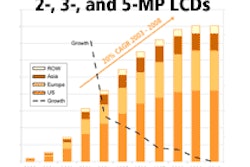High-resolution liquid crystal display (LCD) monitors are fast gaining market share over analog-based cathode ray tube (CRT) medical display monitors, according to a new analysis by Frost & Sullivan. Revenue in this industry totaled $281.1 million in 2004, and could reach $602.9 million in 2011, the Palo Alto, CA-based market analysis firm said.
Even mammography, one of the last bastions of high-end CRT-based displays, has been adopting LCD monitors following the recent Food and Drug Administration approval of 5 megapixel high-resolution screens for diagnostic analysis, Frost & Sullivan stated.
Cheaper CRT displays are still appealing to hospital units with extremely tight capital budgets. However, CRT-based displays are prone to image degradation and drift as early as a year and a half after installation, requiring regular manual calibration for the next three to four years of their active life. In contrast, flat-panel display images are more stable. Installing a new backlight can correct drifting in the rare event it occurs, according to the firm.
In addition, flat-panel LCD displays are now available with automated calibration software packages, Frost & Sullivan said. Although more expensive than their manually calibrated counterparts, these automated solutions offer numerous advantages, such as ensuring DICOM conformance through backlight stability, and documenting the time of testing and any adjustments, according to the company, which advises a full cost analysis over time before monitor purchases are made.
By AuntMinnie.com staff writers
June 1, 2005
Related Reading
PET/CT market on the rise, April 25, 2005
European IGS market on the rise, April 18, 2005
Price breaks fuel European ultrasound market, April 12, 2005
Legacy vendors dominate fragmented European HIS market, March 29, 2005
Payor changes aid brachytherapy in U.S., February 1, 2005
Copyright © 2005 AuntMinnie.com



















